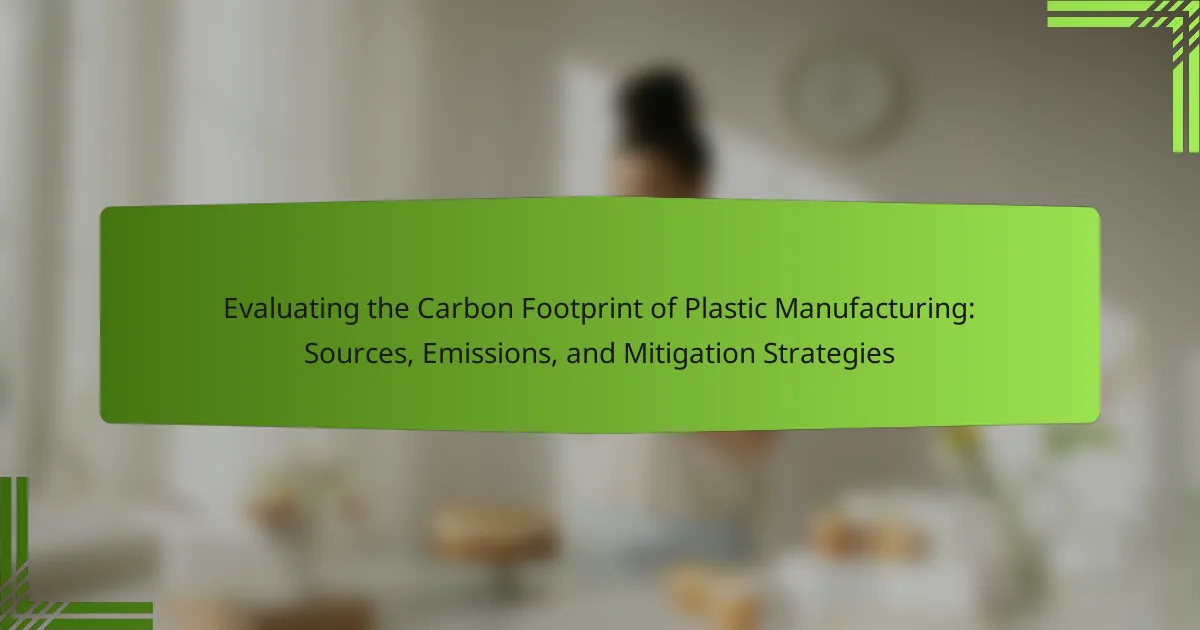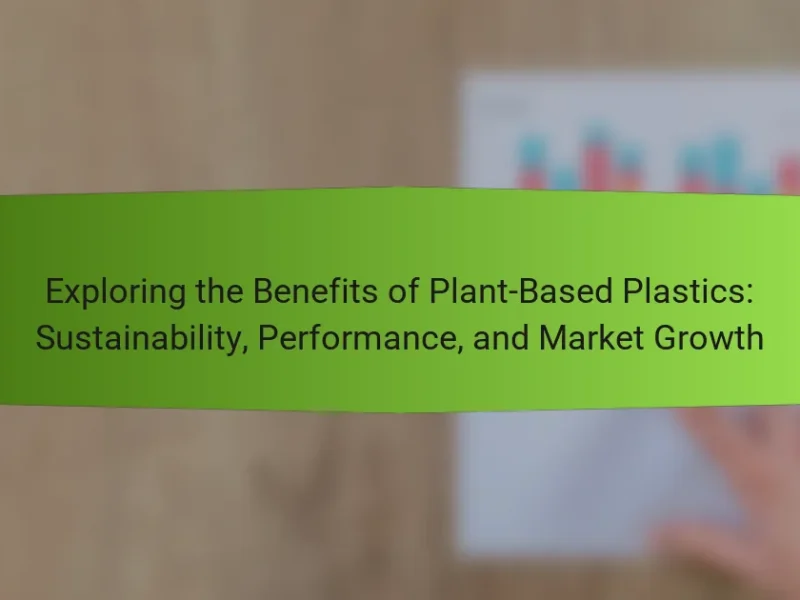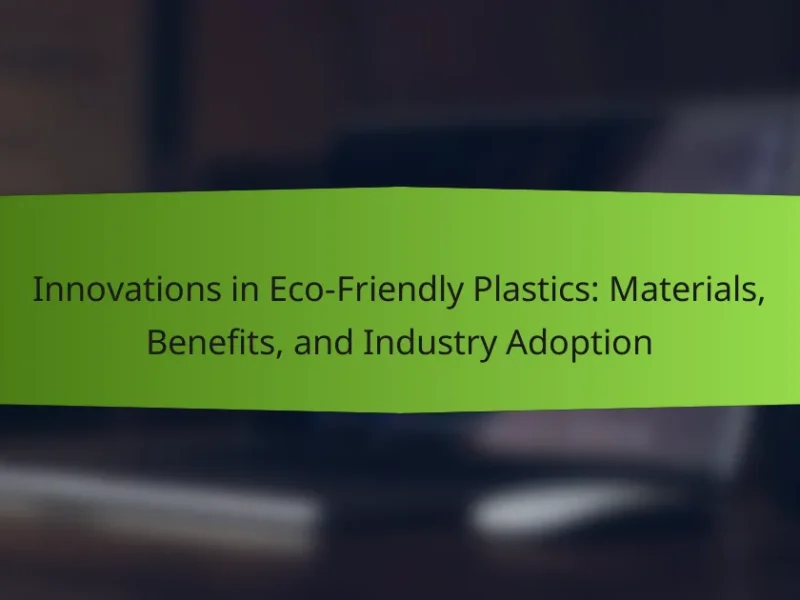The article evaluates the carbon footprint of plastic manufacturing, highlighting its significant contribution of approximately 3.8 billion metric tons of CO2 equivalent emissions annually. Key sources of these emissions include fossil fuel extraction, production processes, and transportation, with the production of polyethylene alone generating about 1.9 kg of CO2 per kg of plastic produced. The article also discusses mitigation strategies such as adopting sustainable materials, improving energy efficiency, and enhancing waste management practices, emphasizing the potential of transitioning to a circular economy to reduce plastic waste and emissions. Overall, the lifecycle of plastics accounts for 10-15% of global greenhouse gas emissions, underscoring the urgency of addressing this environmental challenge.

What is the Carbon Footprint of Plastic Manufacturing?
The carbon footprint of plastic manufacturing is significant, contributing approximately 3.8 billion metric tons of CO2 equivalent emissions annually. This process primarily involves the extraction and processing of fossil fuels, which are used as raw materials. The production of plastic emits greenhouse gases at various stages, including extraction, refining, and polymerization. For instance, the production of polyethylene, a common plastic, generates about 1.9 kg of CO2 per kg of plastic produced. Moreover, energy consumption during manufacturing further increases emissions, with fossil fuels often being the primary energy source. Studies indicate that the entire lifecycle of plastics, from production to disposal, accounts for about 10-15% of global greenhouse gas emissions.
How is the carbon footprint of plastic manufacturing measured?
The carbon footprint of plastic manufacturing is measured through a life cycle assessment (LCA). LCA evaluates the environmental impact of a product from raw material extraction to disposal. It quantifies greenhouse gas emissions at each stage of production. This includes extraction, transportation, processing, and end-of-life treatment. Data is collected on energy usage, material inputs, and emissions during these processes. Emission factors are applied to convert activity data into carbon dioxide equivalents. This method provides a comprehensive view of the total carbon emissions associated with plastic manufacturing. Studies show that plastic production contributes significantly to global greenhouse gas emissions, highlighting the importance of accurate measurement.
What key metrics are used in carbon footprint assessments?
Key metrics used in carbon footprint assessments include greenhouse gas emissions, energy consumption, and material usage. Greenhouse gas emissions are typically measured in carbon dioxide equivalents (CO2e). Energy consumption is quantified in kilowatt-hours (kWh) or megajoules (MJ). Material usage metrics track the types and quantities of raw materials involved in production. Other metrics may include transportation emissions and waste generation. These metrics provide a comprehensive overview of the carbon footprint associated with processes, especially in plastic manufacturing. Accurate assessment relies on established methodologies like the Greenhouse Gas Protocol and ISO 14064 standards.
What role do lifecycle assessments play in measuring emissions?
Lifecycle assessments (LCAs) play a critical role in measuring emissions by providing a comprehensive evaluation of the environmental impacts associated with all stages of a product’s life. LCAs analyze emissions from raw material extraction, production, distribution, use, and disposal. This holistic approach enables the identification of key emission sources throughout the product lifecycle. By quantifying greenhouse gas emissions, LCAs help manufacturers understand their carbon footprint. They also inform decision-making for reducing emissions and improving sustainability. Research indicates that LCAs can reveal significant emission reductions, often ranging from 20% to 50%, through optimized processes and material choices. Thus, LCAs are essential tools for assessing and mitigating emissions in plastic manufacturing.
Why is evaluating the carbon footprint important?
Evaluating the carbon footprint is important because it helps identify the environmental impact of activities and products. Understanding this impact is crucial for making informed decisions that reduce greenhouse gas emissions. The carbon footprint quantifies emissions in carbon dioxide equivalents, providing a clear measure of sustainability. Businesses can use this information to improve operational efficiency and reduce costs. Additionally, consumers can make environmentally conscious choices based on carbon footprint data. Research shows that companies actively managing their carbon footprint can enhance their brand reputation and gain a competitive advantage. For example, a study by the Carbon Trust indicates that organizations reducing their carbon emissions can save up to 20% on energy costs.
How does plastic manufacturing impact climate change?
Plastic manufacturing significantly contributes to climate change through greenhouse gas emissions. The production process releases carbon dioxide and methane, primarily from fossil fuel extraction and processing. According to the United Nations Environment Programme, plastic production and use account for approximately 3.8 billion metric tons of greenhouse gases annually. This figure is projected to increase as global plastic demand rises. Additionally, the incineration of plastic waste emits further CO2, exacerbating the problem. The extraction and transportation of fossil fuels for plastic production also disrupt ecosystems, leading to additional carbon release. Therefore, plastic manufacturing has a profound and detrimental impact on climate change.
What are the economic implications of carbon emissions in plastic production?
Carbon emissions in plastic production have significant economic implications. They contribute to climate change, which can lead to increased costs for businesses. These costs arise from potential regulatory measures aimed at reducing emissions. Companies may face higher operational expenses due to carbon taxes or emissions trading schemes. Additionally, consumer preferences are shifting towards sustainable products. This shift can impact sales for companies heavily reliant on traditional plastic production. A report by the World Economic Forum highlights that the plastic industry’s carbon footprint could cost the global economy up to $120 billion annually by 2030 if unaddressed. Therefore, addressing carbon emissions is crucial for economic sustainability in the plastic sector.

What are the primary sources of emissions in plastic manufacturing?
The primary sources of emissions in plastic manufacturing are fossil fuel extraction, production processes, and transportation. Fossil fuel extraction emits greenhouse gases during drilling and refining. The production processes, including polymerization and compounding, also release significant emissions. For instance, the production of polyethylene generates around 1.8 kg of CO2 per kg of plastic. Transportation of raw materials and finished products contributes additional emissions, particularly when fossil fuels are used for shipping. Overall, these sources collectively contribute to the carbon footprint of plastic manufacturing, which is estimated at 1.3 billion metric tons of CO2 annually.
What materials contribute most to carbon emissions in plastic production?
Fossil fuels, particularly natural gas and petroleum, contribute most to carbon emissions in plastic production. These materials are used as feedstocks in the manufacturing process. The production of plastics like polyethylene and polypropylene relies heavily on ethylene and propylene, derived from fossil fuels. According to the World Economic Forum, the plastic industry accounts for approximately 3.8% of global greenhouse gas emissions. Additionally, the extraction and refining of fossil fuels emit significant carbon dioxide. This highlights the environmental impact of the materials used in plastic manufacturing.
How do fossil fuels impact the carbon footprint of plastics?
Fossil fuels significantly increase the carbon footprint of plastics. Plastics are primarily derived from petrochemicals, which are extracted from fossil fuels. The extraction, refinement, and processing of fossil fuels release substantial greenhouse gases. For instance, producing one ton of polyethylene, a common plastic, emits approximately 1.8 tons of carbon dioxide. Additionally, the combustion of fossil fuels during plastic manufacturing contributes to air pollution and climate change. This reliance on fossil fuels results in a higher overall carbon footprint for plastic products.
What alternative materials can reduce emissions?
Biodegradable materials can significantly reduce emissions compared to traditional plastics. These alternatives include polylactic acid (PLA) and polyhydroxyalkanoates (PHA). PLA is derived from renewable resources like corn starch. PHA is produced by microbial fermentation of sugars or lipids. Both materials decompose naturally, minimizing landfill contributions. Studies show that using PLA can reduce greenhouse gas emissions by up to 80% compared to conventional plastics. Additionally, natural fibers such as hemp and jute can replace synthetic fibers in textiles. These materials require less energy to produce and can sequester carbon during their growth.
How do production processes influence emissions?
Production processes significantly influence emissions through various stages of manufacturing. Different methods of production, such as injection molding or extrusion, release varying amounts of greenhouse gases. The choice of raw materials affects the emission levels; for example, fossil fuel-based plastics typically have higher emissions than bio-based alternatives. Energy consumption during production also plays a crucial role; processes powered by renewable energy generate fewer emissions. Additionally, inefficiencies in production can lead to increased waste and higher emissions. Studies indicate that optimizing production processes can reduce emissions by up to 30%. Therefore, careful selection and management of production methods are essential for minimizing emissions in plastic manufacturing.
What are the emissions associated with different plastic manufacturing processes?
Plastic manufacturing processes generate various emissions. The primary emissions come from the production of raw materials, energy consumption, and the processing stages. For instance, the production of polyethylene emits approximately 1.7 kg of CO2 per kg of plastic produced.
Polypropylene production can result in emissions of about 1.3 kg of CO2 per kg. Additionally, manufacturing processes such as extrusion and injection molding contribute to greenhouse gas emissions through energy use.
In total, the plastic industry is responsible for around 3.8% of global greenhouse gas emissions. These emissions arise from fossil fuel extraction and refining, as well as from the combustion of fuels used in manufacturing processes.
Research indicates that transitioning to renewable energy sources could significantly reduce these emissions.
How can process optimization reduce the carbon footprint?
Process optimization can significantly reduce the carbon footprint by enhancing efficiency in production. It minimizes waste and energy consumption during manufacturing processes. For instance, optimizing machinery settings can lower energy usage by up to 20%. Streamlined workflows reduce unnecessary steps, cutting down on time and resources used. Improved material usage also leads to less waste, which directly correlates with lower emissions. According to a study by the Environmental Protection Agency, efficient processes can decrease greenhouse gas emissions by 15-30%. Implementing these strategies not only benefits the environment but can also lead to cost savings for manufacturers.

What mitigation strategies can be implemented in plastic manufacturing?
Mitigation strategies in plastic manufacturing include adopting sustainable materials, improving energy efficiency, and enhancing waste management practices. Sustainable materials, such as bioplastics, reduce reliance on fossil fuels. Energy efficiency can be improved through advanced technologies and practices, which lower greenhouse gas emissions. Enhanced waste management practices involve recycling and reusing materials, thus minimizing waste generation. According to the Ellen MacArthur Foundation, transitioning to a circular economy can significantly reduce plastic waste and emissions.
What are the most effective strategies for reducing emissions?
The most effective strategies for reducing emissions in plastic manufacturing include adopting renewable energy sources, improving energy efficiency, and enhancing recycling processes. Transitioning to renewable energy can significantly lower carbon footprints. For example, using solar or wind energy reduces reliance on fossil fuels. Improving energy efficiency through advanced technologies also minimizes emissions during production. Implementing closed-loop recycling systems can decrease the need for virgin materials, thus reducing overall emissions. According to the Ellen MacArthur Foundation, increasing the circular economy in plastics can cut greenhouse gas emissions by up to 70% by 2030.
How does recycling impact the carbon footprint of plastic?
Recycling significantly reduces the carbon footprint of plastic. When plastic is recycled, it requires less energy compared to producing new plastic from raw materials. For instance, recycling PET plastic can save up to 76% of the energy needed for virgin production. This reduction in energy consumption leads to lower greenhouse gas emissions. The Environmental Protection Agency (EPA) states that recycling and composting prevented the release of approximately 186 million metric tons of carbon dioxide equivalent into the air in 2013. Thus, recycling not only conserves resources but also plays a crucial role in mitigating climate change by lowering carbon emissions associated with plastic production.
What role does innovation play in emission reduction?
Innovation plays a critical role in emission reduction by introducing new technologies and methods. These advancements can enhance energy efficiency and reduce greenhouse gas emissions. For example, the development of biodegradable plastics can significantly lower carbon footprints compared to traditional plastics. Additionally, renewable energy sources, such as solar and wind, can power manufacturing processes, further decreasing emissions. Research indicates that implementing innovative practices can lead to a 20-30% reduction in emissions within the plastic manufacturing sector. This demonstrates that innovation is essential for achieving significant emission reductions.
How can companies measure the effectiveness of mitigation strategies?
Companies can measure the effectiveness of mitigation strategies by assessing key performance indicators (KPIs) related to emissions reductions. They can track changes in carbon emissions before and after implementing strategies. Comparing baseline emissions data with post-implementation data provides clear insights. Companies can also utilize life cycle assessments (LCAs) to evaluate the environmental impact of their operations. Regular audits and monitoring systems can help ensure compliance with sustainability goals. Engaging stakeholders for feedback can highlight areas for improvement. Utilizing industry benchmarks allows for comparison with peers. Studies show that companies employing these methods see a clearer understanding of their mitigation impacts.
What metrics should be tracked to evaluate success?
Key metrics to track for evaluating success in reducing the carbon footprint of plastic manufacturing include greenhouse gas emissions, energy consumption, and waste generation. Greenhouse gas emissions should be measured in CO2 equivalents to assess overall impact. Energy consumption metrics should focus on total energy use and the proportion derived from renewable sources. Waste generation metrics should track both the volume of waste produced and the rate of recycling. Additionally, water usage and the life cycle assessment of products can provide insights into sustainability. Monitoring these metrics allows for informed decision-making and strategy adjustments to enhance environmental performance.
How can continuous improvement be achieved in emissions management?
Continuous improvement in emissions management can be achieved through systematic monitoring and evaluation of emissions data. Regularly assessing emissions sources allows organizations to identify areas for reduction. Implementing best practices and innovative technologies can further minimize emissions. Engaging employees in sustainability initiatives fosters a culture of accountability. Setting measurable targets and reviewing progress periodically ensures alignment with environmental goals. Utilizing feedback mechanisms helps refine strategies over time. Adopting industry standards and certifications can enhance credibility and performance. Studies show that companies with robust emissions management practices report significant reductions in their carbon footprints.
What practical steps can manufacturers take to reduce their carbon footprint?
Manufacturers can reduce their carbon footprint by implementing energy-efficient practices. They should conduct energy audits to identify areas for improvement. Upgrading to energy-efficient machinery can significantly lower energy consumption. Utilizing renewable energy sources, such as solar or wind, can further decrease reliance on fossil fuels.
Optimizing transportation logistics minimizes emissions from shipping products. Manufacturers can also reduce waste by adopting circular economy principles. Implementing recycling programs for materials can lower the demand for new resources. Collaborating with suppliers who prioritize sustainability enhances overall carbon reduction efforts.
According to the Carbon Trust, energy efficiency measures can reduce carbon emissions by 20-30%.
The main entity of this article is the carbon footprint of plastic manufacturing. The article evaluates the significant contributions of plastic production to global greenhouse gas emissions, estimating approximately 3.8 billion metric tons of CO2 equivalent emissions annually. It details the measurement of carbon footprints through life cycle assessments, key metrics used in evaluations, and the primary sources of emissions, including fossil fuel extraction and production processes. Additionally, the article outlines effective mitigation strategies, such as adopting renewable energy, improving energy efficiency, and enhancing recycling practices, to reduce the carbon footprint in the plastic manufacturing sector.


